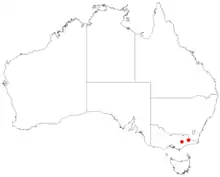| Stringybark tea-tree | |
|---|---|
| Scientific classification | |
| Kingdom: | Plantae |
| Clade: | Tracheophytes |
| Clade: | Angiosperms |
| Clade: | Eudicots |
| Clade: | Rosids |
| Order: | Myrtales |
| Family: | Myrtaceae |
| Genus: | Leptospermum |
| Species: | L. jingera |
| Binomial name | |
| Leptospermum jingera | |
 | |
| Occurrence data from AVH | |
Leptospermum jingera, commonly known as the stringybark tea-tree,[2] is a species of shrub that is endemic to Victoria, Australia. It has papery bark on the larger branches, smooth bark on the younger stems, narrow egg-shaped to elliptical leaves, white flowers and silky-hairy, hemispherical fruit.
Description
Leptospermum jingera is a shrub that typically grows to a height of 0.5–2 m (1 ft 8 in – 6 ft 7 in) and has papery bark on the larger branches, smooth bark on the younger stems, the younger stems silky hairy at first. The leaves are narrow egg-shaped to elliptical, 6–10 mm (0.24–0.39 in) long and 2–3.5 mm (0.079–0.138 in) wide on a petiole about 1 mm (0.039 in) long. The flowers are arranged singly or in pairs in leaf axils and are 6–10 mm (0.24–0.39 in) in diameter. The floral cup is silky-hairy, 2.5–3 mm (0.098–0.118 in) long and 1.5–2 mm (0.059–0.079 in) wide and the five sepals are narrow triangular, about 1 mm (0.039 in) long. The five petals are white, circular and 3–4 mm (0.12–0.16 in) wide and there are between ten and thirteen stamens. Flowering mainly occurs from December to January and the fruit is a hemispherical capsule 2–3 mm (0.079–0.118 in) long and wide with the remains of the sepals attached.[3][4]
Taxonomy and naming
Leptospermum jingera was first formally described in 1996 by Andrew Lyne and Michael Crisp in the journal Australian Systematic Botany, based on plant material collected by Lyne from Brumby Point on the Nunniong Plateau in the Alpine National Park in 1994.[3][5] The specific epithet (jingera) is an Aboriginal word meaning "remote and mountainous, bush-covered country", referring to the habitat of this species.[3]
Distribution and habitat
Stringybark tea-tree grows in low woodland and shrubland and is only known from the type location and The Watchtower in the Snowy Range in Victoria.[3][4]
Conservation status
This species is listed as "vulnerable" on the Victorian Government Department of Sustainability and Environment's Advisory List of Rare Or Threatened Plants In Victoria.[2]
References
- ↑ "Leptospermum jingera". Australian Plant Census. Retrieved 10 April 2020.
- 1 2 "Advisory list of rare or threatened plants in Victoria - 2014" (PDF). Government of Victoria Department of Environment and Primary Industries. Retrieved 10 April 2020.
- 1 2 3 4 Lyne, Andrew M.; Crisp, Michael D. (1996). "Leptospermum jingera (Myrtaceae - Leptospermoideae): A new species from north-eastern Victoria". Australian Systematic Botany. 9 (3): 301–306. Retrieved 10 April 2020.
- 1 2 "Leptospermum jingera". Royal Botanic Gardens, Victoria. Retrieved 10 April 2020.
- ↑ "Leptospermum jingera". APNI. Retrieved 10 April 2020.